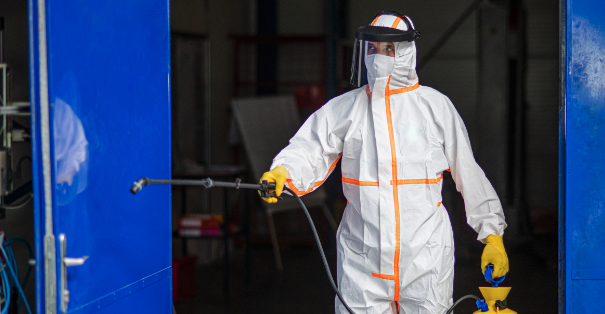SafeDE News
Smarter workplaces are safer workplaces. SafeDE is your resource for OSHA news, regulation changes, recalls, and everything to keep your business safe.
Crane Hand Signals: Guide to OSHA-Compliant Safety
Cranes and other lifting machinery facilitate the safe and efficient transportation of large and heavy loads. However, the disadvantage of using heavy equipment is the loud noise they produce, creating communication barriers at the work site.
Crane hand signals are developed to streamline communication in loud environments where heavy machinery operates. These signals work to keep the team on the same page during ground operations, ensuring not only their safety but also the timely completion of the project.
Operator and Signal Person
Cranes are typically controlled by a single person or the “operator”. Due to their size and design, cranes present a tendency to obstruct the operator's field of vision, affecting their ability to fully perceive the path of movements.
To address these situations and ensure safe and efficient usage of the crane's controls, the assistance of a "signal person" becomes necessary. A signal person plays a huge role in preventing accidents and promoting effective crane operation.
Three Types of Signals - Voice, Audible, Hand
A signal person is trained to communicate with the crane operator using three types of signals: voice, audible, and hand.
- Crane voice signals involve the use of oral communication, unassisted by any sound amplification device.
- Crane audible signals make use of horns, whistles, or bells to generate sounds that alert the operator.
- Crane hand signals do not require any form of verbal communication, making them useful in situations where the signal person needs to relay instructions to the operator as long as they are within visual contact.
Signals must be established before starting any crane operation. When the signal person loses the ability to transmit signals to the operator, the operator must pause all crane operations until contact is reestablished.
19 Standard Crane Hand Signals
OSHA (Occupational Safety and Health Administration) specifies the standard crane signals in CFR 1926, under Appendix A of Subpart CC "Cranes and Derricks in Construction." The following hand signals are commonly used on-site:
- Emergency Stop – The signal person extends both arms out from the body, palms facing down, arms swinging back and forth. This tells the crane operator to immediately cease all activities because of an emergency situation.
- Stop – The signal person holds their arm out with extended fingers and the palm of their hand facing down. The arm is then swung back and forth. This tells the operator to stop the crane, usually when no more movement is needed to be done.
- Raise Boom – The signal person extends one arm out to the side with the hand in a thumbs-up position. This tells the crane operator to raise the boom, a long, hydraulic arm that the crane uses to lift heavy objects.
- Lower Boom – The signal person extends one arm horizontally to the side with the thumb pointing down and the other fingers closed. This tells the crane operator to raise the boom.
- Swing – The signal person extends one arm out horizontally, with the index finger pointing in whichever direction the boom needs to swing.
- Hoist – The signal person extends one arm vertically, points with the index finger, and makes small circles with that finger. This motion tells the crane operator to hoist the load upward.
- Lower – The signal person’s arm and index finger are pointing down and they are making small circles with the hand and index finger until the desired outcome is achieved. This signal tells the crane operator to lower the load.
- Raise the Boom and Lower the Load – The signal person extends an arm to the side with the thumb pointing up. The fingers of that hand should keep opening and closing until the desired outcome is achieved by the operator.
- Lower the Boom and Raise the Load – The signal person extends one arm horizontally. Keep the thumb pointing down while the fingers open until the load is raised to the desired location.
- Move Slowly – This signals the operator to perform an action slowly by positioning one hand above the other hand which performs the action.
- Dog Everything – The signal person holds both hands in front of their body at waist level. Used in situations where crane operations must temporarily pause or take a “time-out” due to rainfall, the load cannot fit the intended space, or a bystander is too close to the crane.
- Travel / Tower Travel – With all fingers pointing up, the signal person’s arm extends horizontally out and back to make a pushing motion in the direction of travel.
- Trolley Travel – The signal person puts the palm of their hand up with fingers closed, while the thumb points to the direction of motion. The hand is then jerked horizontally toward the direction in which the trolley should travel. Tells the crane operator to move only the trolley.
- Use Main Hoist – The signal person taps the top of their head with one hand and performs another hand signal afterward.
- Use Auxillary Hoist – In situations where the auxiliary hoist (whip line) is needed, the signal person bends one arm at the elbow with the forearm in a vertical position and taps the elbow using the other hand.
Some cranes have telescoping booms, which are multiple extensions that extend in a straight line for added vertical reach. The following hand signals apply to telescoping boom cranes:
- Retract Telescoping Boom – The signal person places both hands to the front at waist level, with the thumbs pointing at each other while the rest of the fingers are closed.
- Extend Telescoping Boom – The signal person places both hands to the front at waist level, with the thumbs pointing outward while the other fingers are closed.
There are also specific hand signals for the use of crawler cranes. These are cranes with crawler tracks in the undercarriage instead of the wheels used by standard mobile cranes.
- Crawler Crane Travel, Both Tracks – The signal person rotates both fists around each other in front of their body. Rotate the fists away from the body to signify forward travel and towards the body for backward travel.
- Crawler Crane Travel, One Track – The signal person raises one fist to indicate which track (left or right) should be locked, then rotate the other first in front of the body towards the direction in which the other track should travel.
Mastering crane hand signals is important for safety and efficient communication at construction sites. While alternative methods like radio communication and other signaling techniques exist, hand signals reign supreme in facilitating seamless interaction during active operation.
Frequently Asked Questions (FAQs)
What are crane hand signals?
Crane hand signals are a series of hand and arm movements that correspond to certain actions that must be performed by a crane operator.
Why are crane hand signals important for safety?
Crane hand signals are important for safety during situations where the signal person cannot reach the crane operator using voice or audible signals.
What is the OSHA standard for crane hand signals?
OSHA defines the standard method of 19 crane hand signals under CFR 1926, Subpart CC “Cranes & Derricks in Construction” Appendix A.
What are some basic crane hand signals?
Every trained signal person must know the crane hand signals for stop, emergency stop, boom movements (raise, lower, extend, swing), and how to hoist or lower the load.
How can crane operators and signal persons communicate effectively?
OSHA recommends three types of signals (voice, audible, and hand) for effective communication between a signal person and the crane operator. All crane activities should only be performed as long as visual or verbal contact between these two people is established.
Get SafeDE News
Workplace safety for all businesses.
SafeDE provides FREE comprehensive onsite surveys for small and medium sized private sector establishments to identify potential workplace hazards, improve safety and health management systems, and assist in voluntary compliance with federal OSHA regulations.
Related News
-1.png)
Essential Tips to Prevent Heat Illness in the Workplace
.png)
GHS Label Requirements for Shipping: Tips and Guidelines
.png)
Lockout Tagout Training: Essential Safety Program

The 5 Rules of Effective Incident Reporting
-1.png)
Preventing Ergonomic Injuries: Tips and Strategies
-1.png)
Tips for Selecting the Right Hard Hat for Electrical Work

Essential PPE for Staying Safe and Comfortable in Hot Work Environments
.png)

-1.png)
.png)

